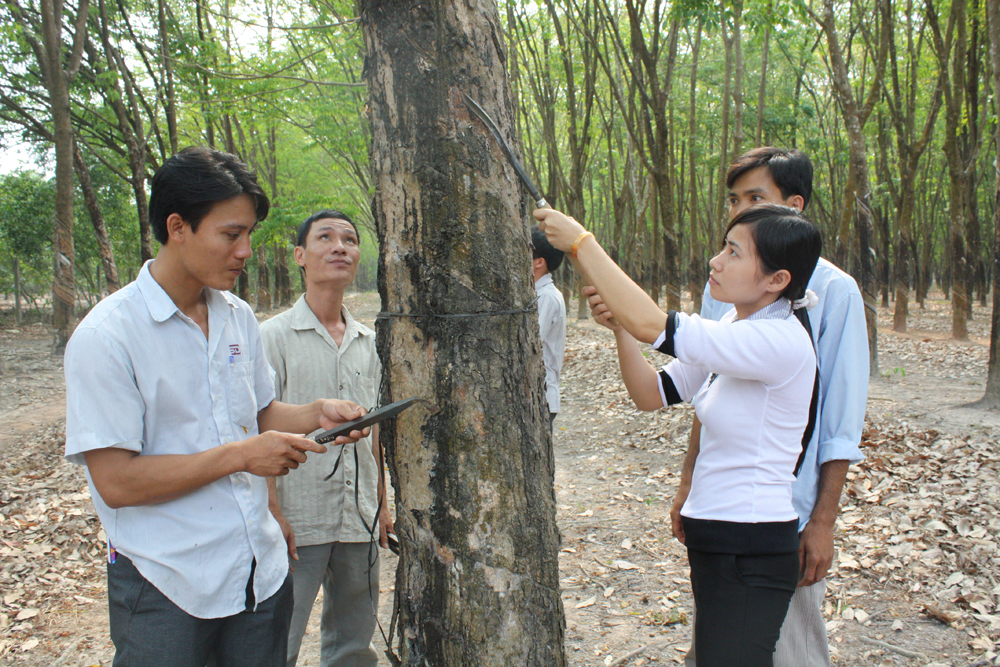Breakthroughs of vocational training for rural working forces
Vocational training for rural working forces has been implemented with determination to offer good conditions for working people to learn whatever is suitable to their competence and earn stable incomes. The training cause has been aimed to improve national pivotal program of constructing new countryside and sustainable poverty reduction to ensure social security and improve material and spiritual lives of the locals.
Rural working forces in Tan Uyen Town are offered training course of rubber tapping
A right direction
Vocational training for rural workers is now necessary for the process of rural modernization and industrialization by creating skillful workers of stable incomes who would lead good lives to contribute to in-depth poverty reduction under national targets in the province.
By our observation, Phu Giao district is a locality of rich land fund to develop agriculture. Thus, the district authority has focused on vocational training of jobs servicing agriculture like rubber cultivation and tapping, ornament plant caring, clean vegetable cultivation, etc. to meet local demands and suit their competence. In the meantime, courses of other jobs like forklift driving, catering, domestic garment making, hair-dressing among others in the trend of social needs and urban development.
Tran Thi Hong Dung, Deputy Chairwoman of Phu Giao district People’s Committee informed that in 10 years of implementing Decision 1956 of the government on training rural labor forces until 2020, the ratio of rural labor has been employed far from the targets, planning, and quality requirements. The vocational training cause for rural working people has contributed to the higher employment in rural areas and improved lives.
Job services in Binh Duong province have been offering vocational training for rural working forces. The center has coordinated with local authorities and unions of Phu Giao, Dau Tieng, Bau Bang, Ben Cat,and Tan Uyen to open vocational classes for rural working people in accordance with Binh Duong provincial planning for vocational training. The trained jobs have been in close relation to economic development programs with transition of rearing animals and plants to meet labor market demands and the program of constructing new countryside. In 2010-2019, total employed rural workers stood at 16,368, of whom, 7,897 are working in agriculture and 10,428 in non-agriculture.
After graduating, the working people would be employed by provincial enterprises who pay good salary. Some have, moreover, registered for classes to improve their competence, actively contributing to national program of poverty reduction at the province.
Effective models
To make the project practical in real life, Provincial Department of Labor, Invalids and Social Affairs coordinated with departments to actively consult with Provincial People’s Committee to issue various directive documents and assign tasks of vocational training for rural working forces in districts, towns, and cities to match with targets and criteria of constructing new countryside. The department has actively coordinated with media agencies of the province and central departments to broadcast TV news and articles about vocational training for rural labor forces.
In 2010-2020, the department has organized pivotal models of effective vocational training in localities of the province. By actual needs, the department has implemented, refined and multiplied vocational training models for rural labor forces to gain achievements, namely the model of State’s agencies (Division of Economics, Labor, and Social Affairs) in coordination with direct vocational training at communes, wards, and townships of the province for those who need jobs. Enterprises have also joined the process (for job groups of non-agricultural sectors) or local unions (for job groups of agricultural sectors). This is considered as the most effective model of the province at the time and will be applied and implemented for the time to come.
Another example is the coordination with local job unions (Association of Farmers, Association of Women, and Association of Youths) to organize vocational training courses for their members. The model is mainly attached to vocational training projects of those associations that have implemented and revised.
The year 2020 is the final year of the project. And, despite great influence of Covid-19 pandemic, local authorities are determined to review the needs of vocational training and labor use to organize courses for rural labor forces in accordance with the planning. Up to date, the province has organized 70 courses for 1,706 trainees, meeting 110.8% of the target for 2020.
Reported by Tuong Vy – Translated by Vi Bao
- Vietnam, India boost education cooperation (25/04)
- Vietnam urged to build legal corridor for AI industry (25/04)
- Food safety in collective canteens of enterprises (24/04)
- Humanitarian Month with significant activities (24/04)
- Solutions to remove obstacles to encourage socialization needed (24/04)
- New Do Bridge inaugurated to cross Thi Tinh River in Ben Cat town (23/04)
- Proposal to recognizing Phu An commune as meeting cultural model new rural standards in 2023 (23/04)
- Ben Cat and efforts to develop comprehensive education (23/04)
 Food safety in collective canteens of enterprises
Food safety in collective canteens of enterprises
 Humanitarian Month with significant activities
Humanitarian Month with significant activities
 New Do Bridge inaugurated to cross Thi Tinh River in Ben Cat town
New Do Bridge inaugurated to cross Thi Tinh River in Ben Cat town
 Ben Cat and efforts to develop comprehensive education
Ben Cat and efforts to develop comprehensive education
 Work plan promotes national digital transformation for socio-economic development
Work plan promotes national digital transformation for socio-economic development
 Vietnam acts to combat white pollution
Vietnam acts to combat white pollution
 Together with the disabled overcome difficulties
Together with the disabled overcome difficulties
 Provincial Red Cross awards scholarships to disadvantaged students in Thu Dau Mot City
Provincial Red Cross awards scholarships to disadvantaged students in Thu Dau Mot City
 Ben Cat town war veterans in active participation in law dissemination
Ben Cat town war veterans in active participation in law dissemination
 Provincial Poor Children's Support Fund awards 100 scholarships to poor students
Provincial Poor Children's Support Fund awards 100 scholarships to poor students





